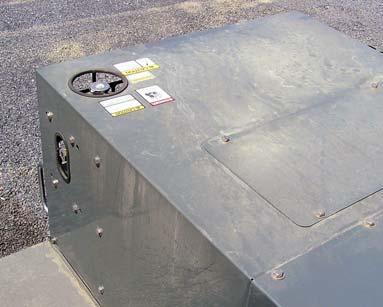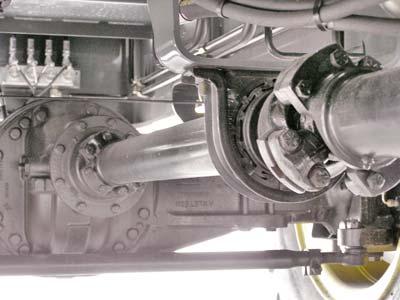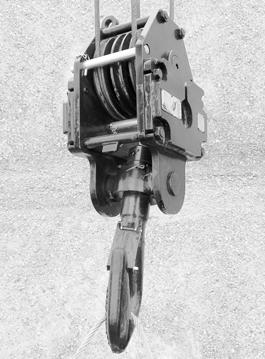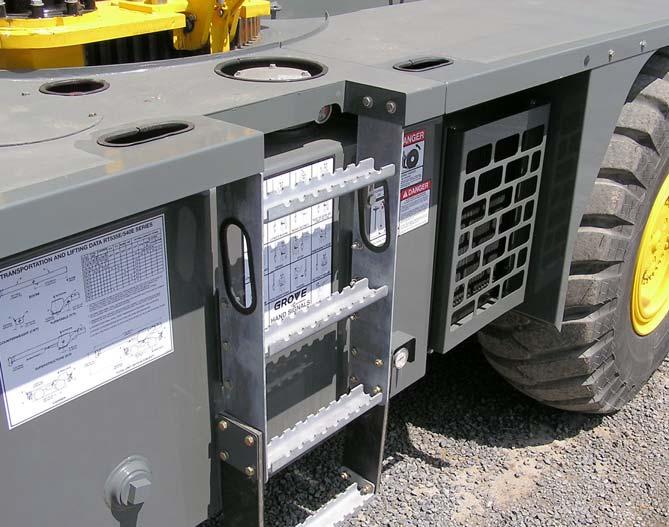
10 minute read
RT540E OPERATOR MANUALLUBRICATION
Arctic Conditions
Below -18°C (0°F)
In general, petroleum based fluids developed especially for low temperature service may be used with satisfactory results. However, certain fluids, such as halogenated hydrocarbons, nitro hydrocarbons, and phosphate ester hydraulic fluids, might not be compatible with hydraulic system seals and wear bands. If you are in doubt about the suitability of a specific fluid, check with your Manitowoc distributor or Manitowoc Crane Care.
NOTE: All fluids and lubricants may be purchased by contacting Manitowoc Crane Care.
Regardless of temperature and oil viscosity, always use suitable start-up procedures to ensure adequate lubrication during system warm-up.
Arctic Conditions Down To -40°C (-40°F)
ALL Weather Package and Lubricants
Engineering recommends the following lubricants for components for ambient temperatures to -40°F. Special lubricants alone are not sufficient to operate at extreme low temperatures. We also recommend the use of appropriately sized heaters for the hydraulic tank, engine oil pan, engine jacket water and batteries. The operator needs to follow the guide lines as stated in the Operator Manual . We assume that the customer has take steps for use of an appropriate engine antifreeze coolant, have taken care of the fuel, fuel system and starting system. And has done whatever they feel necessary to add insulation for under hood temperatures and meet the engine manufacture's intake air temperature. Other lubricants may be used if they meet the specification of the lubricant that is requested. Please consult factory.
TABLE 5-2: All Weather Lubricants
Surface Protection for Cylinder Rods
Steel cylinder rods include a thin layer of chrome plating on their surfaces to protect them from corroding. However, chrome plating inherently has cracks in its structure which can allow moisture to corrode the underlying steel. At typical ambient temperatures, hydraulic oil is too thick to penetrate these cracks. Normal machine operating temperatures will allow hydraulic oil to warm sufficiently to penetrate these cracks and if machines are operated daily, protect the rods. Machines that are stored, transported, or used in a corrosive environment (high moisture, rain, snow, or coastline conditions) need to have the exposed rods protected more frequently by applying a protectant. Unless the machine is operated daily, exposed rod surfaces will corrode. Some cylinders will have rods exposed even when completely retracted. Assume all cylinders have exposed rods, as corrosion on the end of the rod can ruin the cylinder.
It is recommended that all exposed cylinder rods be protected using Boeshield® T-9 Premium Metal Protectant. Manitowoc Crane Care has Boeshield® T-9 Premium Metal Protectant available in 12 oz cans that can be ordered through Manitowoc Crane Care (request P/N 9999101803).
Cylinder operation and inclement weather will remove the Boeshield® protectant; therefore, inspect machines once a week and reapply Boeshield® to unprotected rod
Wire Rope Lubrication
Wire rope is lubricated during manufacturing so that the strands, and individual wires in strands, may move as the rope moves and bends. A wire rope cannot be lubricated sufficiently during manufacture to last its entire life. Therefore, new lubricant must be added periodically throughout the life of a rope to replace factory lubricant which is used or lost. For more detailed information concerning the lubrication and inspection of wire rope, refer to WIRE ROPE in Section 1- INTRODUCTION in the Service Manual.
Lubrication Points
A regular frequency of lubrication must be established for all lubrication points. Normally, this is based on component operating time. The most efficient method of keeping track of lube requirements is to maintain a job log indicating crane usage. The log must use the engine hourmeter to ensure coverage of lube points that will receive attention based on their readings. Other lubrication requirements must be made on a time basis, i.e. weekly, monthly, etc.
All oil levels are to be checked with the crane parked on a level surface in transport position, and while the oil is cold, unless otherwise specified.
On plug type check points, the oil levels are to be at the bottom edge of the check port.
All grease fittings are SAE STANDARD unless otherwise indicated. Grease non-sealed fittings until grease is seen extruding from the fitting. One ounce(28 grams) of EP-MPG equals one pump on a standard one pound (0.45 kg) grease gun.
Over lubrication on non-sealed fittings will not harm the fittings or components, but under lubrication will definitely lead to a shorter lifetime.
On sealed U-joints, care must be exercised to prevent rupturing seals. Fill only unt il expansion of the seals first becomes visible.
Unless otherwise indicated, items not equipped with grease fittings, such as linkages, pins, levers, etc., should be lubricated with oil once a week. Motor oil, applied sparingly, will provide the necessary lubrication and help prevent the formation of rust. An Anti-Seize compound may be used if rust has not formed, otherw ise the component must be cleaned first.
Grease fittings that are worn and will not hold the grease gun, or those that have a stuck check ball, must be replaced. Where wear pads are used, cycle the components and relubricate to ensure complete lubrication of the entire wear area.
CraneLUBE
Manitowoc highly recommends the use of CraneLUBE lubricants to increase your crane’s reliability and performance. Contact your Manitowoc Distributor for information about the Manitowoc’s CraneLUBE lubrication program.
Safety
To lubricate many of the locations the engine will need to be started. After positioning areas of the unit for lubrication the engine must be turned off and the moved areas stable before approaching.
Danger
Crushing Hazard!
Movement of superstructure and boom may create a crushing and/or pinching hazard. Failure to observe this warning could result in death or serious injury.
Steering and Suspension


•Check
•Drain and fill every 4000 hours or 2 years
Fill to bottom of hole in housing on the steer cylinder side
NOTE: Lube level close enough to the hole to be seen or touched is not sufficient. It must be level with the hole. When checking lube level, also check and clean housing breathers.
CAUTION: Use of non-approved lubricant may damage components and/or invalidate published lubricant intervals.
CAUTION: If the makeup amount is substantially more than 0.23 liter (0.5 pint), check for leaks. 9
•Check level every 500 hours or 3
•Drain and fill every 4000 hours or 2
Fill to the bottom of the level hole in the housing with the fill plug and the oil level mark horizontal.
CAUTION: Use of non-approved lubricant may damage components and/or invalidate published lubricant intervals.


EO-15W/40 Engine Oil
SAE 15W-40
•Check level every 10 hours or daily
•Check level through dipstick.
T3 Engine6829003483
T4 Engine6829104182
17.5 l (18.5 qt)
•Drain, fill and replace filter every 500 hours or 6 months
•Check level every 10 hours or daily
Transmission, Torque Converter a. Dipstick b. Filter
Figure 5-3 HYDO Hydraulic Oil 6829006444
23.6 l (25 qt)
•Drain and refill every 1000 hours or 6 months
•Fill engine oil through fill cap on engine valve cover. 14a 14b
•Change transmission filter after first 50 and 100 hours of service, then every 500 hours thereafter
Through fill pipe to FULL mark on dipstick
NOTE:
•Check fluid level with engine running at 750 rpm idle and the oil at 180 to 200 ° F (82 to 93° C). Do not attempt an oil level check with cold oil. To bring the oil temperature to this range, it is necessary to either work the crane or stall the converter. Converter stall should be accomplished by engaging shift lever in forward high range with the brakes applied and then accelerating the engine to half or three-quarter throttle. Hold the stall until the required converter temperature is reached and stabilized. Do not operate the converter at stall condition for longer than 30 seconds at one time. Shift to neutral for 15 seconds and repeat the procedure until the desired temperature is reached. Excessive temperature, i.e, 250° F (120° C) maximum will cause damage to transmission clutches, fluid, converter and seals.
•Drain and fill with the oil at 150 to 200° F (65 to 93° C).
•Transmission filters are located on the outside left hand frame in the area of the hydraulic oil cooler.
•To add fluid: a. Fill to FULL mark on dipstick b. Run engine at 750 rpm to prime torque converter and lines
16
•Check coolant level every 10 hours or daily
•Check SCA levels every 500 hours
•Check coolant for contamination every 1000 hours
Change strainer screen after first 100 hours and every 2000 hours or 12 months intervals thereafter.
See Service Manual c. Check oil level with engine running at 750 rpm and oil at 180 to 200° F (82 to 93° C (180 to 200° F). Add oil to bring oil level to FULL mark on dipstick. 15
Close shutoff valves. Unscrew hex plug to clean filter.






Drive Train (continued)
17 Driveline - Slip Joints Figure 5-4
EP-MPG Extreme Pressure Multipurpose Grease 6829003477
Until grease extrudes 500 hours or 3 months2 grease fittings
•Replace/Clean filter element when indicator shows red (25” H20).
52 Air Cleaner FilterFigure 5-4------
•View indicator through grill from rear of crane.
•Refer to Service Manual a. Fuel Filter
Remove panel behind ladder to access air filter.
53a
53b b. Water Separator Figure 5-4------
•Change filter every 500 hours or 6 months.
•Drain water trap every 10 hours or daily.
•Fuel filter is located on the intake manifold of engine.
•Strainer is located near fuel tank





Brush
Brush lubricant on OD of jack cylinder barrel and wear band before installing jack cylinders 51
Brush lubricant on OD of jack cylinder support tubes (4) places before installing jack cylinders 54
Brush lubricant on inside bottom of outrigger beams where beam extension cylinder guide supports travel



•Check and fill every 50 hours
•Drain and fill after first 250 hours and every 500 hours or 12 months thereafter.
Use dipstick. If no dipstick, fill to top of case.
Coat all teeth 500 hours or 6 monthsSpray on
Until grease extrudes the whole circumference of the bearing
500 hours or 6 months
2 grease fittings at the front of the turntable
NOTE: Rotate the turntable 90° and apply grease to fittings. Continue rotating 90° and grease the fittings until the whole bearing is greased.



NOTE: Lubricate items more frequently than interval indicated in table if environmental conditions and/or operating conditions necessitate.












•Check
NOTE: Line up the Fill/Drain Plug with the upper cutout hole (A). Let hoist sit idle for 20 minutes for an accurate reading. Ensure hoist is level and oil temperature is 21°C ±11°C (70° F ±20°F). If oil level is not visible in sight glass, the hoist may be under filled. Oil escaping from vent plug is an indication the hoist may be over filled. If hoist is over filled, move the Fill/Drain Plug to the lower cutout hole (B) and drain until oil level falls within the sight glass. 47
Thoroughly coat 250 hours or 3 monthsSpray on
NOTE: Lubricate more frequently than interval indicated in table if environmental conditions and/or operating conditions necessitate.


NOTE:
•Use sight gauge on side of tank, with boom down and all outrigger cylinders retracted.
•Drain and refill as necessary
•Environmental and other conditions can dramatically affect the condition of hydraulic oil and filters. Therefore, specific intervals for servicing/changing hydraulic oil, filters and hydraulic tank breathers cannot be set. However, it is imperative for the continued satisfactory performance of Grove cranes that inspections be performed on the basis of how and where each crane is used. Air borne and ingested contaminants can significantly reduce the life of oil and the condition of hydraulic oil filters and tank breathers.
•Under normal operating conditions, it is recommended that hydraulic oil, filters and breathers be inspected and oils sampled at least every 3 to 6 months and more frequently for severe operating conditions. The inspections should be for air borne and/or ingested particles and water that deteriorate and contaminate the oil (e.g., oil appears “milky” or no longer has a transparent clear to amber color). The return filter by-pass indicator should be observed daily to determine if the contaminants content may be high. If the indicator reaches the red zone or indicates a by-pass condition, the hydraulic oil must be sampled. The hydraulic tank breather should also be inspected to assure that it is not restricting air flow into and out of the reservoir.
•To inspect hydraulic oil, fill a small glass container with a sample of reservoir oil and another glass container with fresh oil. Let the samples stand, undisturbed, for one to two hours and then compare the samples. If the reservoir oil is heavily contaminated with water the sample will appear "milky" with only a small layer of transparent oil on top. If the "milky” appearance was due to air foaming, it will dissipate and the oil should closely match the fresh oil. Should you have any questions, please contact your local authorized Manitowoc distributor.
•The hydraulic oil shall meet or exceed ISO #4406 class 17/14 cleanliness level.


Section 6
Maintenance Checklist Section Contents
General
This section contains a list of daily inspection and maintenance checks. Performing the checks will help maintain the safety, dependability, and productivity designed into your crane.
Refer to your Inspection and Lubrication Service Log for further requirements.
Daily or 10 Hour Check List
Instructions
Refer to your Service Manual for specific maintenance and adjustment procedures.
Refer to Section 5 - Lubrication (in this Operator Manual) for lubrication intervals, types of fluids and lube point locations.
1 Operator Manual: Is item properly installed on machine?
2 Signal and Running Lights and Horn: Check for cracked or broken glass. Check for proper working order.
3 Back-up Alarm: Check for proper operation while operating machine.
4 Gauges and Instruments: Check for proper working order. Check for proper reading while operating engine. Check for proper operation while operating machine.
5 Brakes (Swing, Foot and Parking): Check for proper working order. Check for proper operation while operating machine.
6 Boom Angle Indicator: Check for proper operation while operating machine.
7 Rated Capacity Limiter: Check for proper operation while operating machine. Check connectors and wiring for proper alignment and insulation.
8 Anti-two Block (A2B) Electrical and Hydraulic: Check for proper operation while operating machine. Check connectors and wiring for proper alignment and insulation.
9 Brakes and Air System (if equipped): Check for proper working order. Check for proper operation while operating machine. Drain moisture.
10 Tires: Check for proper inflation/pressure. Check for excessive wear. Check for excess dirt, grease or foreign matter.
11 Hydraulic Tank: Check for proper service/level. Check for excess dirt, grease, or foreign matter.
12 Hydraulic Oil Filter: Check for proper service/level.
13 Wire Rope: Check for damaged, frayed, or broken strands.
14 Hoists: Is item properly installed on machine? Check for excess dirt, grease, or foreign matter. Check for proper operation while operating machine.
15 Boom and Attachments: Is item properly installed on machine? Check for excess dirt, grease, or foreign matter. Check for proper operation while operating machine.
16 Engine: Check for proper service/level. Check for excess dirt, grease, or foreign matter.
17 Transmission/Torque Converter: Check for proper service/level.
18 Cooling System: Check for proper service/level. Check for cracks or leaks.
19 Fuel/Water Separator: Drain moisture.
20 Air Cleaner: Check for proper service/level. Check for cracks or leaks.
21 Hook Block and Headache Ball Safety Latch: Check for proper working order. Check for cracks and leaks. Check for excessive wear.
22 Lock-out Cylinder and Swing Potentiometer: Check for proper operation while operating machine. Check for proper adjustment.
Weekly or 50 Hour Check List
1 Sheaves: Check for proper operation, excessive wear, and damage.









